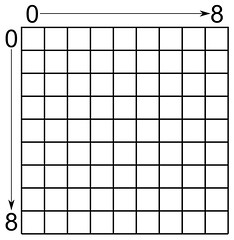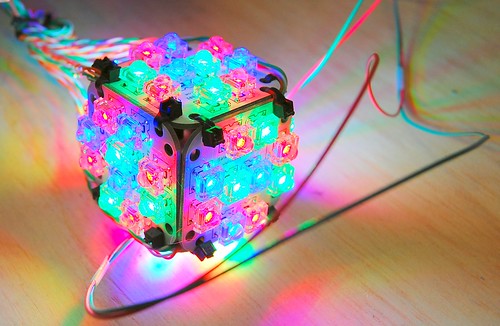

LEDEmergency Fake MoonA friend was having birthday party late yesterday, to coincide with viewing the total lunar eclipse. That evening I realized there was quite a lot of cloud cover, and it was cold outside. I decided to build a moon simulator so that we could keep an eye on the eclipse regardless of the weather. Submitted by Garrett on Tue, 12/21/2010 - 18:09. RGB Pixel TreeWe got our Christmas project done a bit later than usual this year, but here it is. An eight-foot wooden triangle filled with 51 MegaBrite RGB LED modules, controlled by an Arduino. As our projects always do...this also lights the houses across the street pretty well, running about 75 watts of LEDs maximum. Unfortunately didn't take photos during construction, but it's nothing too difficult. Three 1x4 planks fastened at the corners with metal brackets, 3/4 square dowel cross beams, and lots of zip ties. The MegaBrites are daisy chained from a bottom corner up to the top in a zig-zag pattern. Power is connected every 7 or 8 modules, to a 7.5V 20A Meanwell supply from Jameco. For rain protection and a little diffusion, the whole thing is wrapped in a 2mil plastic drop cloth. Submitted by Garrett on Sat, 12/18/2010 - 22:51. Giant magnet - with sparksWas running out of ideas for a Halloween costume, and fell back on the old standby "Mad Scientist". I mean, I have all the stuff already :) The sad part is for the past couple years I've spent so much time working on a really awesome costume, I didn't actually go anywhere! Two great robot costumes, never to be seen...one even had an Arduino-powered voice changer. *Maybe* this year will be different, assuming I don't think of some last minute enhancement that takes another week. So I had the lab coat and magnet already. The idea was to hang out next to the line for the Insane Clown Posse when they had a concert in town, around the time of the whole "Miracles" meme. I built the giant magnet out of two layers of 2" styrofoam insulation panel from Home Depot. Did not have a hot wire foam cutter, so I made one by running about 20 amps through a piece of 28 gauge magnet wire. So I wanted to use the magnet for the mad scientist costume this weekend, but thought it needed a little more pizazz. Also, some bracing across the ends so it wouldn't get crushed and broken. A piece of clear acrylic seemed like a good idea. Then, I realized that the acrylic could have more than just a structural function. I called up TechShop and reserved some laser time, and etched fractal lightning patterns on three panels. Submitted by Garrett on Sat, 10/30/2010 - 00:57. macetech at the Olympics: ZygotesThe final project we worked on for Tangible Interaction was a redesign and production of a large number of their Zygote interactive LED globe concept. The globes are about six feet across, translucent, filled with helium, and contain LEDs that light the sphere in different colors as they slowly bounce across a crowd. Tangible Interaction has built these before, but they wanted to build a new design from scratch and add several important features. They contacted macetech to work on the design and production of the new Zygote cores. This ended up being a very intense project. We had a solid idea how to proceed at the beginning of the project, but due to worldwide semiconductor shortages, necessary parts were dropping out of stock as fast as they were specified. Every time a part became unavailable, it caused a cascade of design changes that required changing other components, which then became unavailable...and so on. Some parts of the project were completely redesigned several times. Submitted by Garrett on Mon, 03/01/2010 - 12:38. Live Twitter Table using New Bluetooth ShieldIntroductionWaaaaaay back in 2009, we took a coffee/side table from IKEA and wired it with 81 ShiftBrite RGB modules in a 9x9 grid. We took it to Maker Faire Bay Area 2009 and showed it off to thousands of people. However, we never managed to put together some detailed documentation, beyond a few photos.Well, we've decided to revisit the project and show a bit more of how the table is constructed, and maybe give you a few ideas for your own LED table project. Additionally, we've added macetech's new Bluetooth shield functionality and hooked it up to Twitter! By correctly formatting your tweet and including the #ledtable hashtag, you can help create an ever-changing work of art in our living room. Control the Table Simply post a tweet including the hashtag #ledtable and use the following pixel definition format:
Simply post a tweet including the hashtag #ledtable and use the following pixel definition format:
#ledtable 0,3,red; 1,2,green; 4,4,#FD2245; In other words, the first two numbers are x and y coordinates (0 through 8 allowed) and then the pixel color. You can specify a color in HTML format or just use a named color from the below:
The numerical and color values must be separated by commas, and each pixel definition must be ended with a semicolon. The #ledtable hashtag can be anywhere in the tweet, and you can define as many pixels as will fit in the tweet. Whitespace and additional text is not a problem.
We've just got word that some fans helped set up a tweet generator application for the LED table. Check it out here! Thanks to chicklets921 for creating the generator and MikeCyberMe for setting up the hosting. There have been some really cool pictures drawn on the table, but this should help make it a lot easier. Thanks! Live StreamYou can watch the results live on UStream below (if we have the table running at the moment). Unless you want to go to Ustream's page, just click on the little ">" arrow in the lower left corner instead of the big one in the middle of the video.Submitted by Garrett on Tue, 02/23/2010 - 00:01. Berkeley FSM Cafe ShiftBrite Power Meter   This is a great new project that just went live in the FSM Café on the University of California Berkeley campus. It's a floor-to-ceiling energy meter that displays a colorful stacked bar chart of power being used by various appliances within the cafe. It contains Here's a video of the power meter in operation: Submitted by Garrett on Sat, 02/06/2010 - 18:45. "Rare" TLC5947 chips available. Right now (the time of this article) we're the only place you can buy these modules in small quantities and without an 18 to 22 week leadtime. We currently have a surplus of TLC5947DAP chips, purchased for a series of upcoming new products. Due to worldwide semiconductor shortages, this particular chip has been nearly impossible to buy for more than half a year. We finally saw a roll of 2,000 appear on Arrow's website, and it could only be sold as a complete reel. Since there was really no other way to get the quantity we needed, we decided to buy the whole reel and then make half of it available as a service to the general (electronics hobbyist) public. The TLC5947DAP (datasheet) is a powerful LED controller chip from Texas Instruments. It has 24 channels of individually-settable 12-bit PWM, each switching a current-controlled sink driver. The maximum current is set by a single external resistor for the whole chip. This makes the chip perfect for driving 24 LEDs with precise brightness control; ideal for controlling 8 RGB LEDs. The current sinks eliminate the need for external resistors for each LED, with correct supply voltage and heatsinking. Check it out in our store: TLC5947 Submitted by Garrett on Wed, 02/03/2010 - 23:50. 2010 New Year's ball It's been a while since my last post...we've been really busy with some projects the past few months. However, on New Year's Eve I took a couple hours to build a miniature version of the Times Square ball. I did something similar last year, with 32 ShiftBrites and a geometric drinking straw construction. This year I used a lot of plastic cups glued into a sphere, and six Satellite Modules controlled by ShiftBars and an Arduino. There are some more photos and a video available on the 2010 New Year's ball Flickr set.
Submitted by Garrett on Fri, 01/01/2010 - 18:10. LED ShiftBar PumpkinsJason was talking to one of our distributors recently (Paul at Pololu.com). He mentioned that he wasn't going to be at home this year to try putting some ShiftBrites in pumpkins. That sounded like such a good idea, we decided to run with it! We had a bunch of high brightness LED arrays left over from a recent project, and decided to use those to replace the candles in some pumpkins. Each array has 10 five-chip 100mA LEDs: four red, three green, and three blue. The extra red LED was added because they tend to be a little dimmer than the blue and green LEDs. Since the ShiftBar can't control more than 150mA per channel, the LEDs are arranged in series for a higher forward voltage, to approach 4.5W total. The light output is about the same as 15 ShiftBrites, with 5 extra ShiftBrites thrown in for the red channel. Naturally, we had to start with some pumpkins. I got eight of them from Safeway and set them up in the back yard. Our friends Ethan and Karly were coming over for a barbecue, so we added pumpkin carving to the list of activities. They were happy to help carve pumpkins...and also brought food and grilled it for us! The bison burgers were delicious. The pumpkin carving went as usual...disgusting pumpkin guts clinging to everything, etc. Submitted by Garrett on Sun, 10/18/2009 - 02:29. Possible OctoBrite applicationHere's a great video I found on YouTube. A 2009 graduate installed 64 RGB LEDs and 8 TLC5947 drivers along with an Arduino Mini, in a mortar board cap. I don't know the actual dimensions of a typical cap, but 8" per side seems about right. The project in this video could be easily duplicated by using OctoBrites, which are 4" modules containing 8 RGB LEDs spaced 1/2" apart. Cool stuff!
Submitted by Garrett on Mon, 06/29/2009 - 16:14. |
Recent Comments
5 years 2 weeks ago
5 years 2 weeks ago
5 years 4 weeks ago
5 years 11 weeks ago
5 years 18 weeks ago
5 years 19 weeks ago
5 years 23 weeks ago
5 years 23 weeks ago
5 years 26 weeks ago
5 years 32 weeks ago